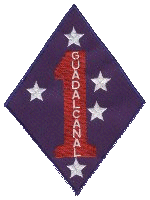
The Guadalcanal Patch
The 1st Division shoulder patch originally was authorized for wear by members of units who were organic or attached to he division in its four landings in the Pacific War. It was the first unit patch to be authorized for wear in World War II and specifically commemorated the division's sacrifices and victory in the battle for Guadalcanal.
As recalled by General Merrill B. Twining, a lieutenant colonel and the division's operations officer on Guadalcanal, for a short time before the 1st left Guadalcanal for Australia, there had been some discussion by the senior staff about uniforming the troops. It appeared that the Marines might have to wear Army uniforms, which meant that they would lose their identity and Twining came up with the idea for a division patch. A number of different designs were devised by both Lieutenant Colonel Twining and Captain Donald L. Dickson, adjutant of the 5th Marines, who had been an artist in civilian life. The one which Twining prepared on the flight out of Guadalcanal was approved by Major General Alexander A. Vandegrift, the division commander.
General Twining further recalled that he drew a diamond in his notebook and "in the middle of the diamond I doodled a numeral one ... [and] I sketched in the word 'Guadalcanal' down its length ... I got to thinking the whole operation had been under the Southern Cross, so I drew that in, too ... About an hour later I took the drawing up to the front of the aircraft to General Vandegrift. He said, 'Yes, that's it!' and wrote his initials, A.A.V., on the bottom of the notebook page."
After he arrived in Brisbane, Australia, Colonel Twining bought a child's watercolor set and, while confined to his hotel room by a bout of malaria, drew a bunch of diamonds on a big sheet, coloring each one differently. He then took samples to General Vandegrift, who chose one which was colored a shade of blue that he liked. Then Twining took the sketch to the Australian Knitting Mills to have it reproduced, pledging the credit of the post exchange funds to pay for the patches' manufacture. Within a week or two the patches began to roll off the knitting machines, and Colonel Twining was there to approve them. General Twining further recalled: "after they came off the machine, I picked up a sheet of them. They looked very good, and when they were cut, I picked up one of the patches. It was one of the first off the machine.
The division's post exchanges began selling the patches almost immediately and they proved to be popular, with Marines buying extras to give away as souvenirs to Australian friends or to send home to families. Before long, newly established Marine divisions, as well as the raider and parachute units, and as the aircraft wings, sea-going Marines, Fleet Marine Force Pacific units, and others, were authorized to have their own distinctive patch, a total of 33, following the lead of the 1st Marine Division. Marines returning to the United States for duty or on leave from a unit having a distinctive shoulder insignia were authorized to wear that insignia until they were assigned to another unit having a shoulder patch of its own. For many 1st Marine Division men joining another unit and having to relinquish the wearing of the 1st Division patch, this rankled.
Shortly after the end of the war, Colonel Twining went to now-Marine Commandant General Vandegrift saying that he "no longer thought Marines should wear anything on their uniforms to distinguish them from other Marines. He agreed and the patches came off for good." -- Benis M. Frank